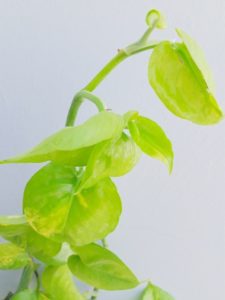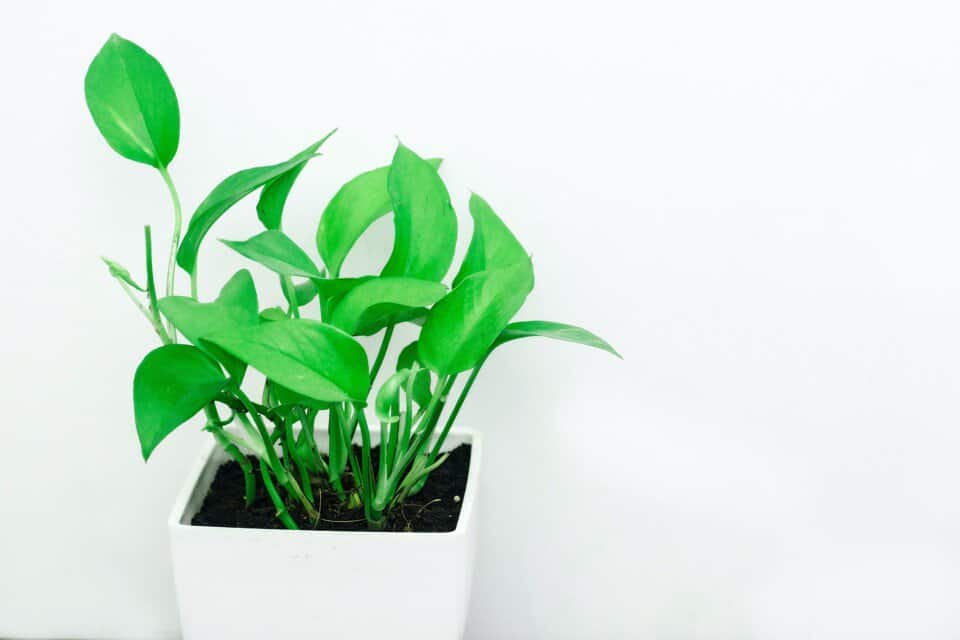Some links in the post are affiliate links and I get a commission from purchases made through some links found in the post.
The pothos plant is also known as Devil’s ivy and is considered to be one of the hardiest houseplants.
It is pretty tough and can withstand very harsh conditions, additionally, few illnesses and diseases can be stronger than it. however, Since you came across this article, you must be wondering “Why is my pothos curling”?
Pothos plants are a little bit curled towards the leaf tips naturally, however, if the leaves turn droopy and start curling, this means that the pothos has a problem and is not healthy.
The main reason your pothos is curling is due to underwatering. Other reasons your pothos is curling is due to overwatering, light, too much fertilizer and pest problems.
Even though in most cases pothos plants foliage curling can be caused by underwatering, it also can be an indication of various problems. Therefore, in this article, we will discuss what can cause pothos plant curling and how to fix it.
Why is my Pothos Curling
 Pothos are low-maintenance plants, although their normal development does require some attention.
Pothos are low-maintenance plants, although their normal development does require some attention.
Pothos plants are mostly impacted by ignorance and environmental stress, which can cause the leaves to curl.
Depending on the circumstances that cause curled leaves, there are different variations of curls that can appear such as upward, downward, and side curls.
Pothos’ curled leaves are a sign of stress. If only older leaves start to change shape, then it is fine and that may be the normal thing to happen.
However, if young and healthy leaves start to curl, then it is a sign that something is not right. If you know how to identify and cure the problem, you will not be wondering “Why is my pothos curling” anymore.
1) Underwatering
If you see your pothos plant foliage curling in on the sides, this may be because of underwatering. The pothos plants keep moisture in their foliage and stem, however, when there is a lack of moisture within them, they limp and wilt.
Because pothos is a resilient plant, growing underwater can even grow in the water in some cases. They won’t maintain healthy leaves if they don’t get water and keep drying up in the heat.
The majority of the time, in the summer, they are thirsty because of the lack of water and excessive heat.
How To Treat Underwatering
There are several things that you can do to help the underwatered plant:
- When I wonder why is my pothos curling, the first thing I do is to check to see if the soil is dry before determining whether it is underwatered. You can check it by putting your finger in the dirt.
- Make sure not to overwater the plant.
- Do not give the plant water that is too cold. It is preferred to give them room temperature water. Additionally, avoid giving it tap water. The preferred water is rainwater or distilled one. If you have no access to either of them, leave the tap water out overnight and let the chlorine and other chemicals evaporate first.
- You can water the plant again when the top 2 inches of soil are dried.
2) Overwatering
Overwatering can be identified by leaves that curl downward and start to turn yellow. Rotted roots are the main issue brought on by too much moisture in the soil.
The underlying cause of many problems of plants’ is root rot. You are lucky if only the leaf tips are curled. this indicates that the root rot is still in its early stages.
How To Help Overwatered Pothos Plant
Root rot is caused by overwatering, which reduces the nutrients and water that Pothos receives from the soil, roots, leaves, and stems.
Pothos roots deteriorate, get sick, and become flooded if they are overwatered. The soil and roots that have started rotting, do not function properly and are unable to breathe and take nutrients from the soil.
If the rotting of the roots has not started yet, Simply slowing down watering will give soil and roots time to dry naturally and completely.
For a more thorough remedy, remove the plant from the soil, carefully untangle the roots and clean them with fresh water. Remove any rotted roots and replant your pothos in well-draining new soil.
3) Light
As a houseplant, pothos is extremely sensitive to light exposure. In a sense, it can endure moderate light indoors, but not strong light.
If outside, somewhat shaded places should be recommended. Pothos require 8–10 hours of light to perform photosynthesis, absorb and deliver nutrients and water and have beautiful variegations.
However, If you wonder “Why is my pothos curling”, then this may be because of its resistance to weak lighting.
If the leaves of your pothos are extending toward the source of light, the area is too dark. Your pothos plant will curl its leaves away from the light source if it is too bright there.
How To Guess Proper Lighting

So, the first thing you must determine is if there is too much or not enough light. You can know it by simply observing the house.
Make sure that the direct sun rays do not hit pothos, and also check and see, maybe you have it placed in a shaded area?
For enough exposure to light, move them to a location near a window, balcony, or beneath a lamp. However, if they get too much light, the soil will dry up faster and the leaves will start to wilt.
If you want to make sure that the pothos plant gets exactly enough light, consider a grow lamp. Artificial light can be a good solution for plants like pothos.
4) Giving Too Much Fertilizer
Fertilizer is an undoubtedly essential part of the plant’s development. It provides the nutrients and minerals that the soil does not has and health with the growth.
However, it is very important to know when and how much fertilizer needs to be given.
Typically, the leaves of pothos that have had excessive fertilization will be smaller, curled downward, or discolored. Because of too much fertilizer, the salt and nitrogen amount will be higher than recommended in the soil.
How To Fix Over Fertilized Pothos
When overfertilizing pothos, you force its metabolism. This plant loves to be fed once every two months during the growing season.
If you use organic, handmade fertilizers or vermicompost, then the risks and outcomes of overfertilization reduce.
The most effective technique to stop overfertilization is if you see any signs of it and see if the plant will recover.
When the plant looks better, then give them much lower doses of fertilizers. As an alternative, you may also use liquid fertilizers.
If the overfertilization is not mild and pothos is harmed seriously, then you will have to do the following to save the plant:
Step 1: Remove the plant from the soil.
Step 2: Clean the roots carefully with the soft brush
Step 3: Put the pothos plant in new and well-draining soil.
5) Pests
Another cause of why my pothos curling may be the pest infestation. Unwanted visitors like mealybugs, spider mites, scales, thrips, etc.
Can cause pothos to acquire curled leaves. Especially if the foliage is wrinkling and has yellow discolorations, you must suspect that the pest infestation is going on.
Pest weakens pothos plants by sucking on their sap-filled stems and leaves. This causes typically both the stem and leaves to be twisted.
How To Fight Pest Infestation
You can use commercially available pest repellants to get rid of pests. However, additionally, the usage of homemade cures is growing, and they can be effective against pests.
To get rid of bugs, you can use various products like dishwasher detergent, neem spray, garlic spray, etc. Here is a short list of what you can do to cure and avoid future infestation:
- Most often, gardeners and plant lovers put peppermint, thyme, spearmint, pine bark, or essential oils to keep the pests away from the plant, and in most cases, this actually works.
- Do not place your plants where the humidity is high and in the spot where the air ventilation is poor. The constant moisture and lack of ventilation attract the pests.
- Check the plant’s foliage constantly to make sure that pests have not started living on your plant.
- Remove the pests that may be stuck on the plant with the soap water.
You can make a good solution for pest removal by mixing 1 teaspoon of oil with 2.5 litres of water. Put the solution in the spray bottle and gently pour it on the plant every week.
This will get rid of the bugs that harm the pothos plant. You can also make a similar mixture with garlic and dish soap.
Final Thoughts
 In this article, we answered your question of “Why is my pothos curling” and discussed some steps that can help you to fix the problem.
In this article, we answered your question of “Why is my pothos curling” and discussed some steps that can help you to fix the problem.
Typically, pothos comes with sturdy, glossy, and heart-shaped leaves that are often straight. Therefore, when it starts to curl, there definitely is a problem.
There are a number of reasons why pothos may be curling, Mostly it is connected with overwatering.
Even though the pothos plant is considered to be low-maintenance, it can be delicate if not cared for properly.
The key is that as long as a few requirements (feeding, watering, light, and temperature) in most cases, those beauties will do just fine. Keep in mind to often check the leaves properly to find out if something is wrong.
With the help of the instructions provided above, If you observe the plant properly and check its symptoms carefully, you will eventually come up with answers and start curing it accordingly.


